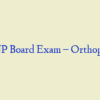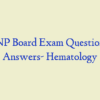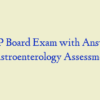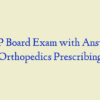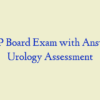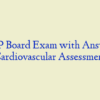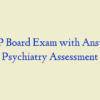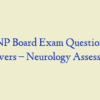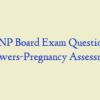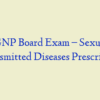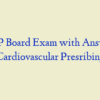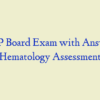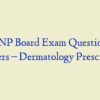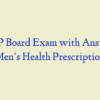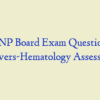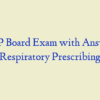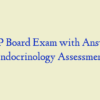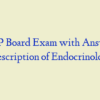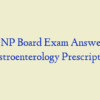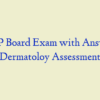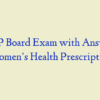Description
AGNP BOARD EXAM QUESTIONS Orthopedics Assessment (317 Questions)
- The axioscapular group of muscles include which one of the following?
- An example of a cartilaginous joint would be the:
- The part of the ulna that forms the outer prominence of the elbow is referred to as the:
- To assess muscle tone in the legs, support the patient’s thigh with one hand, grasp the foot with the other, and:
- When grading muscle strength, a grade of three would indicate:
- Joints in which bones have intervening layers of fibrous tissue or cartilage holding the bones together are referred to as:
- Passive flexion, varus stress, and external rotation of the lower leg evaluates the:
- When examining the knee, the presence of a palpable fluid wave with the returning fluid wave into the suprapatellar pouch is noted. This positive sign for effusion of the knee is known as the:
- The Abduction (or Valgus) Stress Test is a maneuver used to assess the function of the:
- The dorsiflexors muscles in the foot include the:
- Thenar atrophy suggests:
- Pouches of synovial fluid that cushion the movement of tendons and muscles over bone or other joint structures are referred to as:
- A patient experienced a neck injury yesterday and presents to the nurse practitioner with aching paracervical pain and stiffness. Other complaints include dizziness, malaise, and fatigue. These findings may be associated with:
- Women who wear high-heeled shoes with narrow toe boxes are at risk of developing all of the following forefoot abnormalities except:
- Anserine bursitis arises from:
- A 64-year-old man complains of worsening pain that radiates from the right buttock to the posterior upper thigh. This is a common complaint associated with:
- The ankle is a hinge formed by the tibia, fibula, and the:
- The group of muscles that lies medial and swings the thigh toward the body is known as the:
- When examining the elbow for range of motion, the nurse practitioner instructs the patient to turn his palm upward. This motion is an example of:
- The adductor tubbercle of the knee is located:
- A patient complains of low back pain when he walks, but improvement with rest or lumbar flexion. This type of low back pain is referred to as:
- When examining the foot of a patient, the nurse practitioner notes tenderness of the posterior medial malleolus. This could be suggestive of:
- The posterior drawer sign is used to assess instability of the:
- The nurse practitioner instructs the patient to place one hand behind his back and touch his shoulder blade. This shoulder movement elicits:
- The nurse practitioner instructs the patient to move his ear to his shoulder. This maneuver assesses:
- The lateral end of the clavicle that articulates with the acromion process of the scapula is referred to as the:
- The synovial cavity occupies the:
- When performing a musculoskeletal examination, the nurse practitioner instructs the patient to move his arm in front of himself and overhead. This motion of the shoulder girdle would be an example of:
- The structure that projects from the spinal column posteriorly in the midline is referred to as the:
- The nerve that provides sensation to the palm and palmar surface of most of the thumb, second and third fingers, and half of the fourth digit is the:
- Tenderness over the sacroiliac joint is commonly noted in patients with:
- Which one of the following ligaments of the foot is most at risk for injury from inversion?
- A patient complains of a sharp burning pain in the neck and right arm with associated paresthesias and weakness. These symptoms may be associated with:
- When examining the patient for wrist flexion, the nurse practitioner instructs the patient with his palms down to:
- Which of the following substances is essential for bone health and muscle function?
- When examining the ankle and foot, the nurse practitioner instructs the patient to dorsiflex and plantar flex the foot at the ankle. This maneuver assesses the:
- The longest part of the sternum extending from the end of the manubrium to the beginning of the xiphoid process is referred to as the:
- Physical signs associated with cervical radiculopathy from nerve root compression include:
- The axiohumeral group of muscles include which one of the following?
- A normal finding in the musculoskeletal assessment of a 3-year-old child would be the presence of:
- The group of muscles that lies lateral and moves the thigh away from the body is known as the:
- The patella rests on the:
- Located on the anterior aspect of the distal femur, the patella slides on this grove during flexion and extension of the knee. The name of this groove is the:
- The anterior drawer sign is used to assess instability of the:
- Flexion contracture of the knee suggests hamstring tightness or:
- The nurse practitioner instructs the patient to bend at the waist moving from side to side from a standing position. This maneuver would elicit:
- The axiohumeral group of muscles:
- When examining the ankle and foot of a patient, the nurse practitioner instructs the patient to point the foot toward the floor. This motion assesses:
- Genu varum refers to:
- A patient presents with midline, lumbar back pain. The nurse practitioner should assess for:
- Acromioclavicular arthritis usually arises from prior direct injury to the:
- The patellar tendon continues below the knee joint and inserts distally on the:
- The quadriceps femoris muscle of the thigh:
- A thickened nodule overlying the flexor tendon of the 4th finger and possibly the 5th finger near the distal palmar crease is suggestive of:
- Upon examination of the left shoulder, the nurse practitioner notes an inflamed right subacromial bursa. An X-ray of the left shoulder demonstrates a calcium deposit in the AC joint. The patient holds her arm close to her side and experiences extreme pain when attempting any movement of the arm. These symptoms are most likely indicative of:
- Pain and crepitus over the patella suggests:
- A popliteal or “baker’s” cyst arises from:
- When examining the elbow for range of motion, the nurse practitioner instructs the patient to bend his elbow. This motion is an example of:
- he muscle of the scapulohumeral group that runs above the glenohumeral joint and inserts on the greater tubercle is know as the:
- The subtalar joint is locate:
- When perform an examination of a painful left hip on a adult, there is a palpable bogginess over the area. This finding is refer to as:
- The primary hip flexor is the:
- To palpate the lateral meniscus, place the knee in flexion and palpate along the:
- To test the thumb for extension, ask the patient to:
- Blue sclera, weak muscles, and increase joint flexibility during a newborn assessment may be suggestive of:
- The group of muscles that lies anteriorly and flexes the thigh is know as the:
- The tibiotalar joint is locate between the:
- A structural channel beneath the palmar surface of the wrist and proximal hand is know as the:
- The metatarsophalangeal joints are located:
- The structure that supports weight during sitting is the:
- Which finger of the dominant hand is usually the “pleximeter”?
- When examining the foot of a patient, the nurse practitioner notes localized tenderness over the ankle joint. This could be suggestive of:
- The medial and lateral menisci:
- A patient complains of aching pain in the lumbosacral area that radiates into the upper leg. This type of low back pain is referred to as:
- When examining the foot of a patient, the nurse practitioner notes focal heel tenderness on palpation of the plantar fascia. This could be suggestive of:
- A small, tuberculated eminence, curved a little forward, and giving attachment to the radial collateral ligament of the elbow-joint is referred to as the:
- Physical signs sociated with cervical myelopathy from cervical cord compression include:
- When examining the knee, a fluid wave on the medial side between the patella and the femur is noted. This positive sign for effusion of the knee is known as the:
- When screening for scoliosis, assessment should include:
- A long curved bone along the uppermost part of the ilium is known as the:
- Pain that radiates along the dermatome of a nerve due to inflammation or irritation of a nerve root is referred to as:
- The scapulohumeral group of muscles include which one of the following?
- Where the head of the humerus articulates with the shallow glenoid fossa of the scapula is known as the:
- The nurse practitioner instructs the patient to bend forward and try to touch his toes. This maneuver would elicit:
- When examining the elbow, swelling over the olecranon process is noted. This finding could be suggestive of:
- Plantar flexion of the foot is powered by the posterior muscle, toe flexors, and the:
- Upon examination of the foot and ankle, the nurse practitioner notes point tenderness over the posterior aspects of the right malleolus. Additionally, the patient is unable to bear weight after 4 steps. This finding is most consistent with:
- The lateral collateral ligament of the knee:
- On examination of the feet, the nurse practitioner observes a painful thickening of the skin on the bony prominence of the left fifth toe. This lesion is most likely a:
- The deep intrinsic muscles of the back assist with:
- The medial collateral ligament of the knee:
- The groove of the metacarpophalangeal joint can be palpated by having the patient:
- The posterior cruciate ligament of the knee:
- Focal tenderness over the trochanter confirms:
- The thick curved extension of the superior border of the scapula is referred to as the:
- When performing a musculoskeletal examination, the nurse practitioner instructs the patient to move his arm out to the side, away from his body, and overhead. This motion of the shoulder girdle would be an example of:
- Tenderness over the scapulohumeral muscle group with the inability to abduct the arm above the shoulder level would be consistent will all of the following conditions except:
- The semimembranous bursa of the knee lies:
- When perform a musculoskeletal exam on a patient with mechanical low back pain, osteoporosis is suspected. Positive findings would include all of the following except:
- A 35 year old female patient presents to the nurse practitioner with complaints of pain in the joints of both hands accompanied by stiffness, especially in the morning with tenderness and warmth to touch. Examination reveals swelling of the synovial tissue and limitation of motion. These findings are consistent with:
- The joint in the knee formed by the patella and the femur is known as the:
- When examining the ankle and foot of a patient, the nurse practitioner instructs the patient to move the heel outward. This motion assesses:
- On examination of the foot, the nurse practitioner notes acute inflammation of the first metatarsophalangeal joint. This finding could be consistent with:
- What test is perform when the nurse practitioner instructs the patient to hold his wrists in flexion for 60 seconds while pressing the backs of his hands together to form right angles?
- The nurse practitioner is examining the elbow of a 16-year-old male athlete. Increase pain is note when he tries to extend his wrist against resistance. This finding is most consistent with:
- A patient reports pain of the left shoulder when attempting to lift his arm away from his body or when he tries to flex the arm forward. A characteristic shrug of the left shoulder with a positive arm drop is noted. These symptoms could be suggestive of:
- The quadrangular shape of the broad upper part of the sternum is refer to as the:
- When grade muscle strength, a grade of four would indicate:
- Which of the follow symptoms would be suggestive of lumbar spinal stenosis?
- The abdominal muscles and intrinsic muscles of the back assist with:
- Swelling noted over the tibial tubercle suggests:
- When performing a spinal exam, the nurse practitioner noted the appearance of poor posture and a “hump” appearance of the upper back. This finding could be suggestive of:
- The structure that creates a channel for the spinal nerve roots is known as the:
- To test the latissimus dorsi, teres major, posterior deltoid, and triceps brachii muscles, the nurse practitioner would have the patient perform which shoulder movement?
- The area at the posterior aspect of the spine lateral to the sacroiliac joint is known as the:
- The lateral malleolus is located at the:
- When performing a spinal exam, the patient complains of vertebral tenderness. This finding could be suggestive of:
- The medial epicondyle of the femur is located on the:
- The area locate between the olecranon process and the skin is know as the:
- When perform a musculoskeletal examination, the nurse practitioner instructs the patient to move his arm behind himself. This motion of the shoulder girdle would be an example of:
- The groove of the radiocarpal joint is locate:
- Which nerve in the arm originates in the axilla and travels down the arm in a shallow depression on the surface of the humerus?
- The extension of the spine of the scapula locate at the highest point of the shoulder is refer to as the:
- When grading muscle strength, a grade of two would indicate:
- The anterior cruciate ligament of the knee:
- When assessing the knee, the examiner instructs the patient to sit and swing his lower leg toward midline. This motion assesses knee:
- When examining the elbow for range of motion, the nurse practitioner instructs the patient to straighten his elbow. This motion is an example of:
- The nurse practitioner suspects a rotator cuff tear in a patient who is unable to:
- When performing a musculoskeletal examination, the nurse practitioner instructs the patient to move his arm in front of his body. This motion of the shoulder girdle would be an example of:
- When assessing the knee, the examiner instructs the patient to sit and swing his lower leg away from midline. This motion would assess knee:
- The nerve that provides sensation to the dorsal web of the thumb and index finger is the:
- To test the thumb for flexion, ask the patient to:
- The joints that are distal to the knuckle and best felt on either side of the extensor tendon are the:
- The structure that enclose the spinal cord is know as the:
- Physical signs associated with mechanical neck pain include:
- The paravertebral muscles are locate:
- Contracture of the sternocleidomastoid muscle could result in lateral deviation and rotation of the head. This condition is suggestive of:
- When exam the knee, swelling above and adjacent to the patella was note. This finding could be suggestive of:
- The lateral bone that serves as a strut between the scapula and the sternum is know as the:
- Dynamic stabilizers of the shoulder are referred to as those structures that are:
- To test the thumb for opposition, ask the patient to:
- The anserine bursa of the knee lies:
- Flexion and extension of the neck occurs primarily between the skull and:
- When examining the ankle and foot, the nurse practitioner stabilizes the heel and inverts and everts the forefoot. This maneuver assesses the:
- To test the thumb for adduction, ask the patient to place the fingers and thumbs in the neutral position with the palm up and move the thumb anteriorly away from the palm and then:
- When examining the ankle and foot, the nurse practitioner stabilizes the ankle with one hand, grasps the heel with the other and inverts and everts the foot by turning the heel inward and outward. This maneuver assesses the:
- When examining the knee, the patient complains of pain with compression and patellar movement during quadriceps contraction. This finding could be suggestive of:
- The lesser tubercle of the humerus is located:
- On examination of the left wrist, the nurse practitioner notes a slightly tender .75 cm swelling along the joint capsule during flexion of the wrist. This finding could be suggestive of:
- Stumbling or “giving way” of the knee during the heel strike phase of gait suggests:
- The greater tubercle of the humerus is located:
- To test the supraspinatus, anterior and lateral deltoid, and pectoralis major, the nurse practitioner would have the patient perform which shoulder movement?
- Stiffness in a joint and limited motion after inactivity is commonly referred to as:
- Lateral epicondylitis is also referred to as:
- When describing muscle strength, the term paresis means:
- When discussing the musculoskeletal system, which of the following statements is consistent with extra-articular disease?
- The joint that articulates with the concave condyles of the tibia is the:
- When grading muscle strength, a grade of one would indicate:
- When assessing the knee, the examiner instructs the patient to bend his knee. This motion would assess knee:
- The structure that appears as a large swelling posteriorly on the superior ramus of the ischium and bears most of the weight in sitting, is known as the:
- To palpate the trochanteric bursa, position the patient:
- Inspection of the hip begins with careful observation of a patient’s gait. A patient’s foot moves forward without bearing weight. This is known as the:
- When describing muscle strength, the term hemiplegia means:
- A patient reports sharp “catches” of pain, grating, and weakness in the right shoulder when lifting the arm overhead. These symptoms could be suggestive of:
- The nurse practitioner instructs the patient to raise his arm to his shoulder, bend his elbow, and rotate his forearm toward the ceiling. This shoulder movement elicits:
- Crepitus with flexion and extension of the knee suggests:
- To palpate the medial meniscus, slightly internally rotate the tibia and palpate the medial soft tissue along the:
- The small intrinsic muscles are located:
- Collagen fibers connect muscle to bone are know as:
- When assessing a 3-month-old for developmental dysplasia of the hips (DDH), which one of the following symptoms would be suspicious of dysplasia?
- The muscle of the scapulohumeral group that originates on the anterior surface of the scapula and crosses the joint anteriorly and inserts on the lesser tubercle is the:
- With the patient standing and the examiner sitting in the chair, the examiner should observe:
- Swelling on the posterior and medial surface of the knee would be suggestive of:
- When assessing a patient with complaints consistent with carpal tunnel syndrome, which one of the following symptoms is unlikely?
- When discussing the musculoskeletal system, all of the following statements related to articular structure disease are true except which one?
- The area where the iliac crest terminates anteriorly on the ilium is know as the:
- A tool for assessing risk factors for osteoporotic fractures is the:
- With the patient in the dorsal decubitus position, have him slow extend the knee while maintain the varus stress and external rotation. If a snap on the medial joint line is palpated, this may indicate a positive test for a:
- The ligament of the foot that fans out from the inferior surface of the medial malleolus to the talus and proximal tarsal bones is the:
- The structure that creates a channel for the vertebral artery is know as the:
- The calcaneus is locate:
- A dislocation of the elbow joint cause by the sudden pull on the extend pronated forearm is refer to as:
- The nurse practitioner instructs the patient to lie supine, bend his knee, and turn his lower leg and foot away from the midline. This maneuver would assess hip:
- The concavities noted on each side and above the patella are known as the:
- The nurse practitioner instructs the patient to lie supine, bend his knee, and move his lower leg toward the midline. This maneuver would assess hip:
- The prevertebral muscles are located:
- On examination of the feet, the nurse practitioner observes a painless thickening of the skin under the ball of the foot. It is tender to direct pressure. This lesion is most likely a:
- Lateral bending of the neck occurs primarily between the skull and:
- Upon examination of the left shoulder, the left arm is at the patient’s side. The elbow is flexed 90 degrees and the patient is instructed to supinate the forearm against the nurse practitioner’s resistance; increased pain in the bicipital grove results. This finding confirms:
- Olecranon bursitis may be caused by all of the following except:
- When examining the ankle and foot of a patient, the nurse practitioner instructs the patient to point the foot toward the ceiling. This motion assesses:
- The muscle of the scapulohumeral group that crosses the glenohumeral joint posteriorly and inserts on the greater tubercle is known as the:
- A cartilage-like articulation between the pubic bones is known as the:
- A patient complains of shooting pains below the knee radiating into the lateral leg and calf. This type of low back pain is referred to as:
- Metatarsalgia is a term used to describe:
- On examination of a six-week-old infant, developmental hip dysplasia (DDH) is suspected. If DHH is present, it might be evidenced by:
- When examining the ankle and foot of a patient, the nurse practitioner instructs the patient to move the heel inward. This motion assesses:
- When examining the knee, which of the following symptoms would be indicative of a positive Abduction (Valgus) Stress Test?
- When examining the medial and lateral meniscus, a click along the medial joint with valgus stress, external rotation, and leg extension suggests a probable tear of the:
- The prepatellar bursa of the knee lies:
- The gluteus medius and minimus muscles are part which group of muscles in the thigh?
- When examining the ankle and foot, the nurse practitioner moves the proximal phalanx of each toe up and down. This maneuver assesses the:
- An example of a fibrous joint would be the:
- The axioscapular group of muscles:
- A condition result from a forceful throw motion and causing the shoulder to “slip out of the joint” when the arm is abducted and externally rotate is know as:
- When describing muscle strength, the term paralysis means:
- Another term for medial epicondylitis is:
- When assessing the knee, the examiner instructs the patient to straighten his knee. This motion would assess knee:
- When examining the knee, which of the following symptoms could be indicative of a positive Adduction (Varus) Stress Test?
- A sixty-five year-old patient is note to have a positive drop arm test. This finding is consistent with:
- The Lachman Test is use to assess instability of the:
- The nerve that provides sensation to half of the fourth digit and fifth digit is the:
- Which nerve in the arm is located in the ventral forearm and is just medial to the brachial artery in the antecubital fossa?
- The scapulohumeral group of muscles:
- The nurse practitioner instructs the patient to look over one shoulder, then the other. This maneuver would assess cervical:
- On examination of the feet, the nurse practitioner observes a deep, infected lesion on the plantar surface of the left foot. The patient denies pain to touch. He has a history of diabetes. This lesion is most likely a:
- The forward slippage of one vertebrae resulting in spinal cord compression is referred to as:
- When examining the foot of a patient, the nurse practitioner notes a bony projection along the edge of the right calcaneus with minimal pain and tenderness to touch. This could be suggestive of:
- A six-year-old male complains of ankle pain and difficulty walking, but denies any recent injuries. Findings reveal ankle tenderness, decreased mobility and range of motion. The patients temperature of 102 degrees °F. These findings are consistent with:
- A defect in the gastrocnemius and soleus muscles with tenderness and swelling could be suggestive of:
- The nurse practitioner instructs the patient to extend and move his fingers as far apart from each other as possible. This maneuver assesses the fingers and thumbs for:
- While evaluating the thumb, ask the patient to point his thumb upward as the nurse practitioner applies downward resistance. This maneuver tests:
- A patient complains of lateral hip pain while pointing near the trochanter. This type of pain could be suggestive of:
- The principal muscles involved when opening the mouth are the:
- Joint pain that is localize and involves one joint, would be documented as:
- When performing an examination of a painful left elbow on a adult, inspection of the surrounding tissue reveals warmth. This finding could be suggestive of all of the following conditions except:
- Joints in which bones do not touch each other, and the joint articulations are freely moveable (within the limits surrounding ligaments) are call:
- When examining the patient for wrist adduction, the nurse practitioner instructs the patient with his palms down to:
- Rotation of the neck occurs primarily between the skull and:
- The gluteus maximus is know as the primary hip:
- On examination of the feet, the nurse practitioner notes a dusky red swelling extending beyond the margin of the metatarsophalangeal joint of the right great toe. It is hot on palpation and the patient states it is painful to touch. These findings are suggestive of:
- On examination of the shoulder, tenderness is noted just below the tip of the acromion with pain on abduction and rotation and loss of smooth movement. This finding could be suggestive of:
- The joint that provides most of the flexion and extension of the wrist is the:
- Passive flexion, valgus stress, and internal rotation of the lower leg, evaluates the:
- When examining the patient for wrist abduction, the nurse practitioner instructs the patient to position his palms down and:
- The structure that cushions movement between vertebrae is referred to as the:
- Physical signs associated with mechanical neck pain with whiplash include:
- Swelling over the patella suggests:
- When a patient complains of joint pain as progressing from one joint to another, the examiner should consider this pattern of involvement as migratory. This type of involvement would most likely be observed in a patient who has:
- The group of muscles that lies posteriorly and extends the thigh is know as the:
- In the older adult, the test for leg mobility is know as the:
- After attempt to elicit the Moro reflex in a newborn, the nurse practitioner identifies absence of movement of the left arm. The next assessment would be to:
- When examining the patient for wrist extension, the nurse practitioner instructs the patient to place his palms down and to:
- The shoulder derives its mobility from a complex interconnected structure which includes three large bones, three principal muscle groups, and:
- To test the thumb for abduction, ask the patient to:
- If a patient presents with non-midline lumbar back pain, the nurse practitioner should assess for:
- When inspect the shoulder and shoulder girdle, an elevation of the right shoulder was note. This finding could be associate with:
- Upon examination of the left shoulder, the patient complains of a dull, aching pain when attempting active or passive range of motion and localized tenderness with external rotation. These symptoms could be suggestive of:
- The nurse practitioner instructs the patient to lie supine, bend his knee, and turn his lower leg and foot across the midline.
- This maneuver would assess hip:
- When grading muscle strength, a five would indicate:
- When evaluating a patient who complains of thumb pain, the nurse practitioner would test thumb movement by instructing the patient to place his thumb in the palm and then move the wrist toward the midline in ulnar deviation. This maneuver is commonly known as:
- The nurse practitioner would tap lightly over the median nerve in the carpal tunnel to assess:
- Decreased spinal mobility in the lumbar region could be suggestive of:
- When performing an examination of a tender left finger on an adult, the surrounding tissue reveals warmth, edema, and redness. This finding could be suggestive of:
- When inspecting the face, asymmetry is noted. This finding could be suggestive of:
- Restrictions of internal and external rotation of the hip are sensitive indicators of:
- The hamstring muscles flex the knee and are located on the:
- Another term used to describe rotator cuff tendinitis is:
- When performing an examination of a painful left wrist in an adult, there is a palpable crunching sound during flexion. This finding is referred to as:
- The vertebral column angles sharply posteriorly and becomes immovable at the:
- Risk factors related to osteoporosis include all of the following except:
- Static stabilizers of the shoulder are referred to as those structures that are:
- A 65 year old female patient presents to the nurse practitioner with complaints of pain in the right knee, occasional stiffness (especially in the morning) with minimal tenderness to touch. Examination reveals moderate swelling in the knee with a tender bony ridge along the joint margin. These findings are consistent with:
- An irregular shape bony feature at the lateral top of the femur is know as the:
- Peak bone mass is reach by age:
- Prepatellar bursitis arises from:
- The nurse practitioner instructs the patient bend backward as far as possible. This maneuver would elicit:
- When examining the elbow for range of motion, the nurse practitioner instructs the patient to turn his palms downward. This motion is an example of:
- Vasculitis on the extremities and an erythematous to salmon-color rash over the trunk are skin lesions that may be attribute to:
- Joints in which bones are slightly moveable and fibrocartilaginous discs separate the bony surfaces are refer to as:
- Which nerve runs from the spine through the neck, the axilla, and into the arm?
- Which nerve in the arm runs posteriorly in the ulnar groove between the medial epicondyle and the olecranon process?
- The point part of the sternum locate at the inferior end is known as the:
- Swelling note 1-2 inches below the knee joint and on the medial surface of the knee would be suggestive of:
- When grading muscle strength, a zero would indicate:
- The suprapatellar pouch of the knee lies:
- The nurse practitioner instructs the patient look upward at the ceiling. This maneuver assesses cervical:
- A patient presents to the nurse practitioner with complaints of sharp pain at the instep of his right foot which appears suddenly and usually occurring at night. The instep and dorsal surface of the foot appear erythematous and are very tender to touch. Motion is limit due to pain. These findings are consistent with:
- Tenderness at cervical vertebrae 1 – 2 (C1-2) in a patient with rheumatoid arthritis suggests possible risk for:
- When describing muscle strength, the term paraplegia means:
- The bony structures of the shoulder include all of the following except:
- When performing a spinal exam, the nurse practitioner notices unequal heights of the iliac crests. This finding could be suggestive of:
- The nurse practitioner instructs the patient to bend his knees to his chest and pull them to his abdomen. This maneuver would assess hip:
- Restricted abduction of the hip in an adult is common in hip:
- The gastrocnemius and soleus muscles are locate by palpating the:
- The structure that supports weight bearing anteriorly is refer to as the:
- To test the latissimus dorsi, pectoralis major, teres major, and coracobrachialis muscles, the nurse practitioner would have the patient perform which shoulder movement?
- Patients with rheumatoid arthritis may develop subcutaneous nodules at pressure points:
- To test the anterior and lateral deltoid, pectoralis major, coracobrachialis and biceps brachii muscles, the nurse practitioner would have the patient perform which shoulder movement?
- To test the integrity of the Achilles tendon, the examiner would have the patient kneel on a chair. While squeezing the calf, watch for:
- Upon examination of the left elbow, limit motion is note and the patient reports pain and stiffness with movement. Synovial inflammation is note in the grooves between the olecranon process and the epicondyles. These find are most consistent with:
- When test hand grip strength on a patient, the nurse practitioner asks the patient to squeeze which finger (s)?
- When compress the suprapatellar pouch and push the patella sharply against the femur, fluid is note to return to the suprapatellar pouch. This is know as a positive:
- The nurse practitioner instructs the patient to move his extended fingers so that each touches its nearest finger.
- This motion assesses the fingers and thumbs for:
- When inspecting the shoulder and shoulder girdle, the rounded lateral aspect of the shoulder appears flattened. This finding could be associate with:
- Tenderness in the costovertebral angles may signify:
- A decrease in the degree of density in a bone that results in fragile bones is refer to as:
- Which one of the follow conditions can plantar fasciitis be associate?
- The reason a 75-year-old female may experience a pathological fracture would be because of:
- A patient who presents with joint pain and an accompanying butterfly rash on the face is suggestive of:
- The convex medial end of the clavicle that articulates with the concave hollow in the upper sternum is referred to as the:
- The patient is asked to lie face up, bend his knees, and place his feet flat on the table. Lifting his buttocks off the table assesses hip:
- Following injury to the extremities, assessment for neurovascular competency should include the:
- The nurse practitioner instructs the patient to make a fist with his left hand then to place the left thumb on top of the distal fingers. This motion assesses the fingers and thumbs for:
- The lateral epicondyle of the femur is located on the:
- The most appropriate position for examining a patient’s knees would be having the patient:
- The medial malleolus is located at the:
- Children with Legg-Calve Perthes disease should:
- A patient complains of aching pain in the neck and points to the cervical paraspinal muscles and ligaments. He complains of muscle spasms and stiffness in the upper back and shoulder for the past 6 weeks. These findings may be associate with:
- A decrease in the amount of density in a bone is refer to as
- The nurse practitioner instructs the patient move his chin to his chest. This maneuver assesses cervical:
- Inspection of the hip begins with careful observation of a patient’s gait. A patients foot is on the ground bearing weight. This is know as the:
- Immediate treatment for a sprain includes:
- The nurse practitioner instructs the patient to lie supine, and move his lower leg away from the midline. This maneuver would assess hip:
- Tenderness over the patellar tendon or inability to move the knee, suggests:

